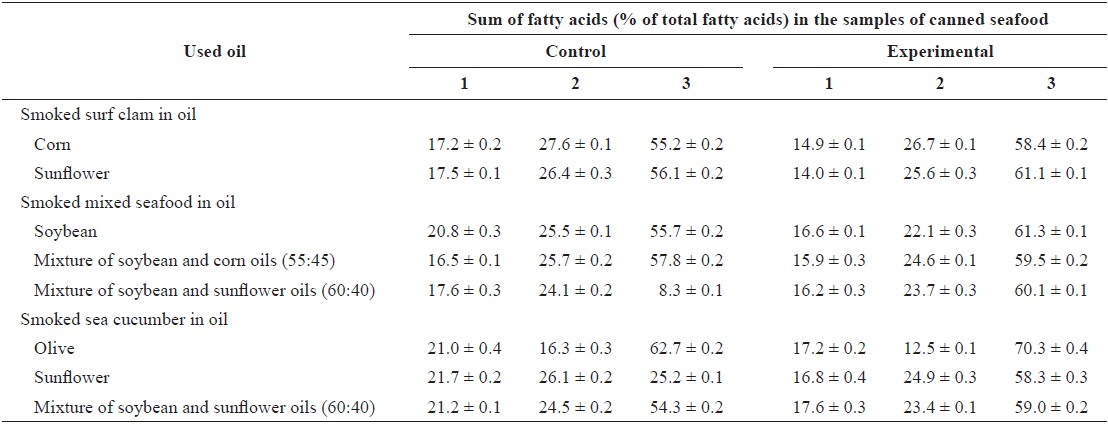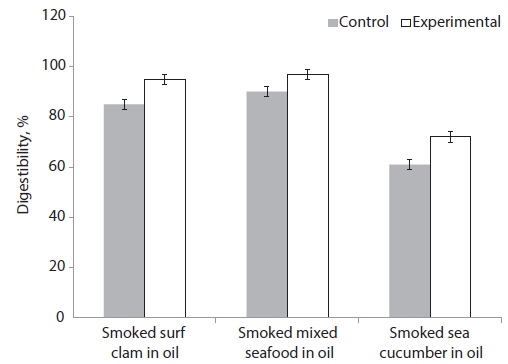



Microbiological safety is a fundamental property to be considered in the creation and development of technology for food processing and preservation. Some techniques used to ensure microbiological safety, including the addition of preservatives, increases in acidity, and high-temperature processing, result in the destruction, inactivation or growth stabilization of microorganisms. However, such measures often lead to reductions in food quality.
For food preservation, canning, a technology that relies on high-temperature processing or sterilization, provides a reliable means of securing microbiological safety. In most countries, including Russia, the sterilization of fish and non-fish food products is conducted to kill spoiling and pathogenic organisms (Giprorybflot, 1996; Shul’gina, 1995). As a quality test organism, highly heat-resistant spores of
Although the sterilization process secures microbiological safety, it results in the loss of native properties of products and has some undesirable effects, including the accumulation of products of nutrient destruction, the formation of high-molecular-weight nitrogen compounds, and reductions in food digestibility and assimilation (Shvydkaya and Blinov, 2008; Shulgin, 2006; Shulgin et al., 2006). A well-known method of reducing the heat resistance of spore microorganisms in canned seafood and decreasing the requisite rigidity of sterilization modes is through the creation of an acidic environment in the canned product (Mazokhina-Porshnyakova et al., 1977), which is barely acceptable for fish and non-fish goods canned in oil. This method allows for effective sterilization without an excessive thermal load on canned food, thus guaranteeing the commercial sterility of food products. The aim of this work was to investigate the influence of spice-oil extract on the heat resistance of microorganisms in canned seafood, the modes of product sterilization, and the quality of the product.
The preparation of semi-finished canned seafood products was carried out in accordance with “The technological instructions for preparing canned seafood from non-fish objects” (Giprorybflot, 1989). The following ingredients were used in canning: frozen sea cucumber, frozen octopus, frozen surf clam, frozen squid, frozen whelk, frozen sea scallop, frozen mussels, refined sunflower, corn, soybean and olive oils, edible salt, powdered black pepper, powdered allspice and milled cinnamon. Spice-oil extract was prepared as follows; milled spices (cinnamon, allspice, black pepper) and vegetable oils were mixed, heated and incubated at 80℃ for 24-36 h. The mixture was cooled and the sediment and spice-oil were separated (Lazhentseva et al., 2011). The cut and washed seafood meat was placed on grids in a smoking room. The flue-curing mode was employed for 20 min at 23-25℃, until the seafood attained the mellow flavor and light aroma of smoked seafood meat. The prepared seafood was batched by size and packed in 90-g glass jars. Twenty cubic centimeters of spice-oil extract or vegetable oil were poured into the experimental and control jars of canned seafood, respectively. The spice-oil extract was a clear flavored oil with a brownish tinge and pleasant cinnamon smell, from which microorganisms were absent (Lazhentseva, 2011). After filling, the jars were rolled using a vacuum, and the patterns of their heating during the sterilization process in water at a counter pressure of 0.18MPa at 115℃ in an AV-2 autoclave were investigated. To compare canned food quality, five experimental cans of each product and five control cans of seafood with added vegetable oil were sterilized.
The canned seafoods, namely, smoked mixed seafood in oil, smoked sea cucumber in oil and smoked surf clams in oil, were produced according to recommendations for developing the sterilization modes of canned fish and fish products (Giprorybflot, 1996; Agribusiness, 2004; Flaumenbaum, 1986).
A suspension of spores of
The constant of the spore heat resistance Dt, where t is a constant temperature, at which 90% of cells die during time interval D, was calculated graphically. The experiment was repeated three times for each extract. The arithmetic mean of the results from three experiments was used. The value of the normative sterilizing effect (Fn in conditional min) was calculated using formula (1):
where D121℃ is the heating time in min required to reduce the amount of
where
The factual digestibility of canned seafood was determined using the biotesting method recommended by Shulgin et al. (2006).
The total lipids in a sample were extracted with chloroform/methanol according to the method of Bligh and Dyer (1959). Total lipids were separated into phospholipids and nonphospholipids using silica cartridges (Alltech, silica, 1.5 mL, 100 mg) according to the method of Juaneda and Rocouelin (1985). The fatty acid content was expressed as a percentage of individual FAME in relation to the total area of the chromatogram (AOAC, 1995).
First, the constant of heat resistance,
[Table 1.] Comparative values of the indicators D121.1 ℃, Fn for canned seafood.

Comparative values of the indicators D121.1 ℃, Fn for canned seafood.
Similarly, the calculated values of normative
Efficient heating time was determined by taking into account the heating of control and experimental canned seafood during sterilization at 115℃. The durations necessary for the effective sterilization of experimental samples were 5 min (smoked surf clam and smoked mixed seafood in oil) to 10 min (e.g. smoked sea cucumber in oil) shorter than those of the control samples (Table 2).

Duration of sterilization and factual sterilizing effect for the control and experimental canned seafood
All canned goods were industrially sterile after sterilization. The addition of spice-oil extract to canned goods resulted in an attractive appearance and a weak aroma of spices.
The replacement of vegetable oil with spice-oil extract can be assessed as effective for its observed ability to decrease the necessary sterilization duration by 5 to 10 min, inflicting thermal damage on microbial contaminants while preserving proteins and biologically valuable nutrients (Brazhnikov, 1987; Gelfand, 1994; Mazokhina-Porshnyakova et al., 1977).
Dutova et al. (1976), Mazokhina-Porshnyakova et al. (1977) and Syromyatnikova (1964) noted that parts of the spore-forming cells of

Influence of oil component on the number of cells Bacillus subtilis in canned seafood in oil
One of the indicators of the degree of the preservation of nutritional value during the sterilization process is the thermal damage of proteins, which affects their digestibility. To assess the effects of spice-oil extract and sterilization modes on the digestibility of proteins, biotesting was carried out. Fig. 1 presents the protein digestibility of the experimental and control samples of canned seafood before and after sterilization. The replacement of vegetable oil by spice-oil extract was accompanied by an increase in accessibility of the canned seafood protein component, with a 10.1% increase in smoked surf clams, an 8.5% increase in smoked mixed seafood and an 8.6% increase in smoked sea cucumber. It is possible that the minor fat-soluble components of spices have a direct positive effect on the digestibility of the proteins contained in seafood canned with spice-oil extract.
Fatty acids are destroyed during thermal processing (Brazhnikov, 1987; Gelfand, 1994). The influence of spice-oil extract on the persistence of the lipid component in canned seafood was estimated by comparing the fatty acid compositions of control and experimental samples of the sterilized products. The oil fraction of canned seafood, which had been stored for 30 days after manufacture, was used to evaluate fatty acid composition.
The fatty acid compositions of canned seafood with various vegetable oils or with their mixture (control) and with spice-oil extract (experimental) are summarized in Table 4.
[Table 4.] Comparative characteristics of fatty acid composition in canned seafood

Comparative characteristics of fatty acid composition in canned seafood
The results indicated differences in the fatty acid contents of oils from the control and experimental samples. The amount of polyunsaturated fatty acids in canned seafood with added spice-oil extract was significantly higher than that in all assortments of canned goods with added vegetable oils. This suggests that the longer duration of sterilization necessary for the control samples alters the fatty acid composition of oils. Fatty acids with shorter carbon chains are formed during the destruction of fatty acids.
The destructive changes in the fatty acid composition of the oil component increased with increasing temperature treatment duration. The thermal processing of canned seafood at 115℃ for an additional 5 min led to the destruction of polyunsaturated fatty acids in canned goods (corn oil, 5.5%; sunflower oil, 8.2%; soybean oil, 9.1%) (Table 4).
Destruction of polyunsaturated fatty acids was greater in the oils of control samples compared to experimental samples (smoked sea cucumber in oil); e.g., sunflower oil (10.5%) and olive oil (10.8%).
The blending of oils promotes an increase in the resistance of the oil components of canned seafood against the action of heat during sterilization, especially when spice-oil extract is used. In seafood canned with a blend of soybean oil and corn oil (55:45) and sterilized for an additional 5 min, the polyunsaturated fatty acid content was reduced by 2.9% compared to that in goods canned with the spice-oil extract. The 10-min reduction in the sterilization duration of seafood canned with an oil mixture or with spice-oil extract promotes the preservation of polyunsaturated fatty acids by 8% compared to goods canned with vegetable oil.
In conclusion, in the manufacture of canned seafood, the substitution of spice-oil extract for vegetable oil reduces the heat resistance of microbial spores, hence enabling effective sterilization of canned goods at 115℃ for a shorter period of time, that is, by 5 to 10 min for canned goods with added spice-oil extract. This 5-10-min reduction in the duration of sterilization at 115℃ of goods canned with spice-oil extract can reduce thermal damage to the major constituent nutrients while maintaining the digestibility of the protein component.






